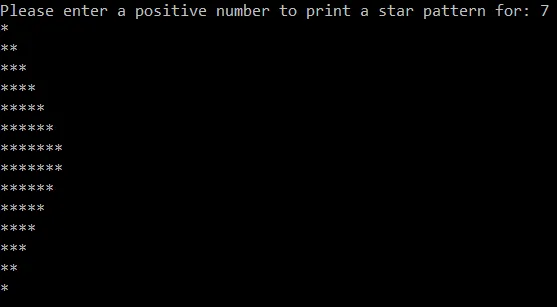For my c++ data structures class our assignment is to print a pattern of stars like this
*
* *
* * *
* * * *
* * * *
* * *
* *
*
with the number of lines in the pattern determined by the user input. So the pattern above would print if the user enters a 4.
We had a previous assignment where we had to print the opposite pattern, one like this
* * * * *
* * * *
* * *
* *
*
*
* *
* * *
* * * *
* * * * *
and the above pattern would print if the user enters a 5. This pattern, the one above, I had no problem with. I used a for loop to print the top half, then recursively called the function again, and then the same for loop to print the bottom half in the opposite direction. For reference, here's the code I used for the above pattern:
int main()
{
int number;
cout << "Enter the number of lines in the grid: ";
cin >> number;
printStars(number);
cout << endl << "Grid Pattern Complete - End of Program.";
return 0;
} // end of main
void printStars(int num)
{
if (num < 0) cout << endl << "Please enter a non negative number." << endl;
else{
if (num == 0) return;
else{
for (int q = 1; q <= num; q++)
{cout << "*";}
cout << endl;
printStars(num - 1);
for (int q = 1; q <= num; q++)
{cout << "*";}
cout << endl;
}
}
} // end printStars
This function works like how I want it, so I figured I would use it as a reference to complete the second assignment. The problem I'm having is that, while it was easy enough to complete the first assignment (printing a line of 4 stars, then a line of 3, then a line of 2 , then a line of 1, then all that again in reverse order), I can't seem to figure out how to format the for loops to print the pattern starting with a line of 1 star, then a line of 2, then a line of 3, and so on, until its called recursively and printed again in reverse order.
For reference, this is the code I have (so far) for the second assignment:
int main()
{
int number;
cout << "Enter the number of lines in the grid: ";
cin >> number;
printStars(number, 0);
cout << endl << "Grid Pattern Complete - End of Program.";
return 0;
}
void printStars(int num, int num2)
{
if (num2 <= num)
{
for (int e = num; e > num2; e--)
{
cout << "*";
}
cout << endl;
printStars(num - 1, num2);
}
}
The only thing this prints is the second half of the pattern;
(If the user enters a 5)
* * * * *
* * * *
* * *
* *
*
And even to make this work, I have to recursively call the function at the end, which is out of order.
I guess I'm just confused on how this recursion is supposed to work but I've been playing with it for hours and I can't seem to reformat it or rearrange it or restructure it so that it prints like I need it to. Can someone give me some guidance? Just maybe write some pseudo code to help me out. This is for school so I need to be able to understand it but I'm really lost right now.
